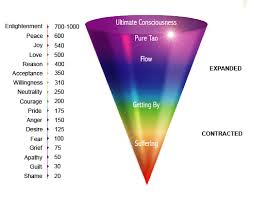
David R. Hawkins, M.D., Ph.D., revolutionized our understanding of human consciousness with his groundbreaking work on the Map of Consciousness. This powerful tool provides insight into the various states of human awareness and their corresponding energy levels. In this article, we'll explore Hawkins' research and its implications for personal growth and spiritual development.
Hawkins developed the Map of Consciousness after conducting over 250,000 calibrations during 20 years of research2. This map uses a logarithmic scale from 1 to 1,000 to represent different levels of consciousness, each associated with specific emotions, attitudes, and energy frequencies2.
-
Lower Levels (Below 200):
-
Shame
-
Guilt
-
Apathy
-
Fear
-
Anger
-
Pride
-
-
Higher Levels (200 and above):
-
Courage
-
Acceptance
-
Reason
-
Love
-
Joy
-
Peace
-
Enlightenment
-
Hawkins identified level 200 (courage) as a crucial turning point on the consciousness scale4. At this level, individuals begin to contribute positively to society rather than merely taking from it. People operating above 200 understand that contributing to the common good ultimately benefits everyone, including themselves4.
Hawkins' research distinguishes between two primary modes of operating in the world:
-
Force (Below 200):
-
Characterized by aggression, manipulation, and self-centeredness
-
Views life as a competition with winners and losers
-
Relies on bullying or coercion to achieve goals
-
-
Power (200 and Above):
-
Marked by cooperation, understanding, and love
-
Recognizes the interconnectedness of all beings
-
Achieves goals through alignment of actions, goals, and values
-
Hawkins' work provides a roadmap for personal growth and spiritual evolution. Here are some key insights for those seeking to raise their level of consciousness:
-
Self-awareness: Recognize your current level of consciousness and its associated behaviors and thought patterns.
-
Intention: Set a clear intention to grow and evolve, moving towards higher levels of consciousness.
-
Practice: Engage in activities that promote higher consciousness, such as meditation, mindfulness, and acts of kindness.
-
Healing: Address and release lower-level emotions and traumas that may be holding you back.
-
Alignment: Strive to align your actions, goals, and values for greater coherence and power.
According to Hawkins, enlightenment begins at a consciousness level of 700 and reaches its peak at 1,0004. At this stage, individuals transcend individual identity and merge with universal consciousness, experiencing a state of perfect understanding and serenity4.
Hawkins' Map of Consciousness has far-reaching implications for various aspects of life:
-
Personal Development: Use the map as a guide for self-improvement and spiritual growth.
-
Relationships: Understand and navigate interpersonal dynamics more effectively.
-
Health and Healing: Explore the connection between consciousness levels and physical well-being.
-
Leadership: Develop more effective and inspiring leadership styles based on higher consciousness principles.
-
Social Change: Work towards raising collective consciousness for positive societal transformation.
David R. Hawkins' research on the levels of consciousness offers a profound framework for understanding human behavior, personal growth, and spiritual evolution. By recognizing where we are on the Map of Consciousness and actively working to raise our energy levels, we can not only improve our own lives but also contribute to the betterment of the world around us.
As we strive to reach higher levels of consciousness, we unlock greater potential for happiness, fulfillment, and positive impact. Hawkins' work serves as a beacon, guiding us towards a more enlightened state of being and a brighter future for humanity.
